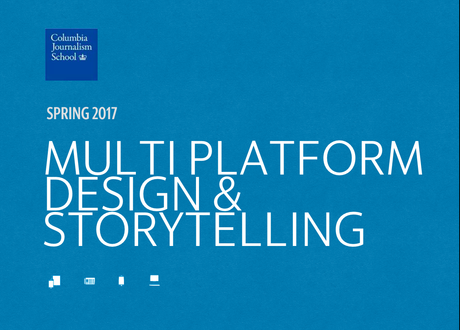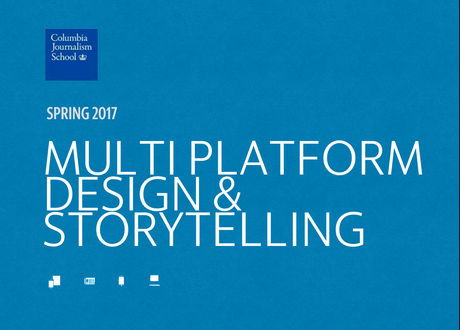

Here we go again, the day when we, the professors, pitch our Spring semester courses to students at Columbia University's Graduate School of Journalism. We have one hour to tell those interested about our class, the assignments, the goals and objectives and an overall view of the class syllabus.
This is the fourth time I will teach Multiplatform Design & Storytelling, but in Spring 2017 this class will not be identical to how I have taught it the past three times. I started looking at the 2016 course syllabus and realized how much our industry has changed in just one short period of time. While the class will continue to emphasize telling stories across platforms, with a final project that involves a multimedia story, much has changed otherwise.
I came to the realization that in our industry there are three major disciplines that come together for whatever we do: storytelling, technology and design. Indeed, I think I would put them in that order, too. If the time allowed, we would tackle the fourth discipline: the economics of the media today and the important of creating projects that help monetize operations. I will include one lecture on economics, but I am convinced that journalists need to be more aware of how the stories they write and the products they create bring in revenue.
What is new for my course?
Two things are going to be totally new in this upcoming semester's course: basic introduction to coding, and more emphasis on the flow of breaking news across platforms. Why the emphasis on these? Because, as I visit newsrooms around the world in my role as a media consultant, I notice that sometimes storytellers and the technical folks seem to be at odds with each other, mostly because there is ignorance on both sides about what the other does.
My teaching assistant is Andy Rossback, a graphics/multimedia editor at The New York Times. Previously, he was an editorial designer at The Marshall Project. The work he was involved with there earned a Pulitzer Prize, as well as World’s Best honors from the Society for News Design. I am also proud to call him a senior art director for Garcia Media. So, Andy and I spent hours discussing the approach I wanted to take to the course, and we both agreed that, in addition to the traditional Design Boot Camp that is an integral part of the course, we would add a hefty component on coding, as well as more emphasis on breaking news and how it flows through the various platforms.
The goal of the course is stated as follows:
Design, especially in the digital space, allows us to add new kinds of texture and dimension to our reporting. This class will deal with the many formats that stories can take and how those formats play out across different devices, as opposed to analysis of mobile apps or platforms on which those stories appear. We will touch on the economics of digital storytelling, as well.
We will learn to blend editorial design essentials (grids, color, type, story structures, motion, user experience) with modern tools for building digital stories (wireframes, front-end development, version control, DNS/hosting, deployment).
Elements of coding
Andy and I have worked hard to weave the basic elements of design and storytelling together with the basics of coding.
As a result, when we cover story structures, typography, grids and color palettes, students will test their competence in these areas by completing assignments that require them to understand coding.
For example, here is a Week 2 sampler of lectures and student assignments:
Read before class: Grids Are Good. Right?
Lecture: Story structures & grids
Bootcamp: Introduction to tools & wireframing in Adobe Illustrator
Assignment 1: Modify the provided wireframe to emulate a story structure discussed in class and overlay a grid for that wireframe. Export and submit a PDF by 10 a.m. Feb. 6.
For those interested in taking a look at the course syllabus
http://https://s3.amazonaws.com/columbia-multiplatform/assets/data/resources/syllabus-v1.pdf

